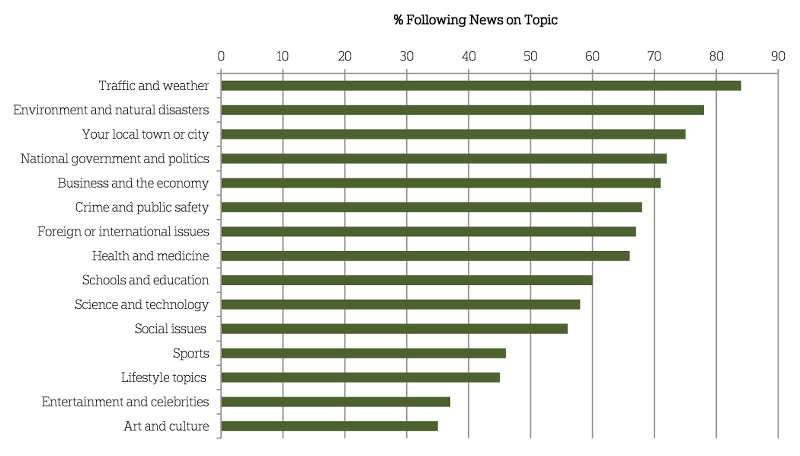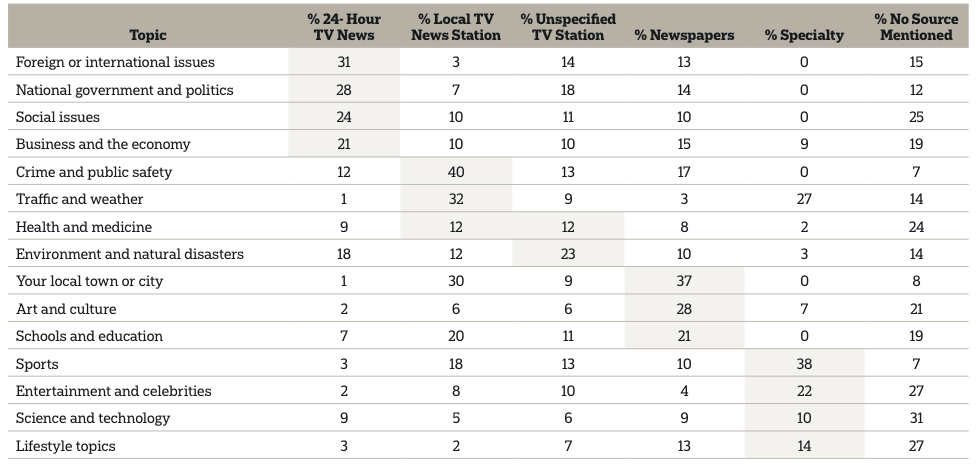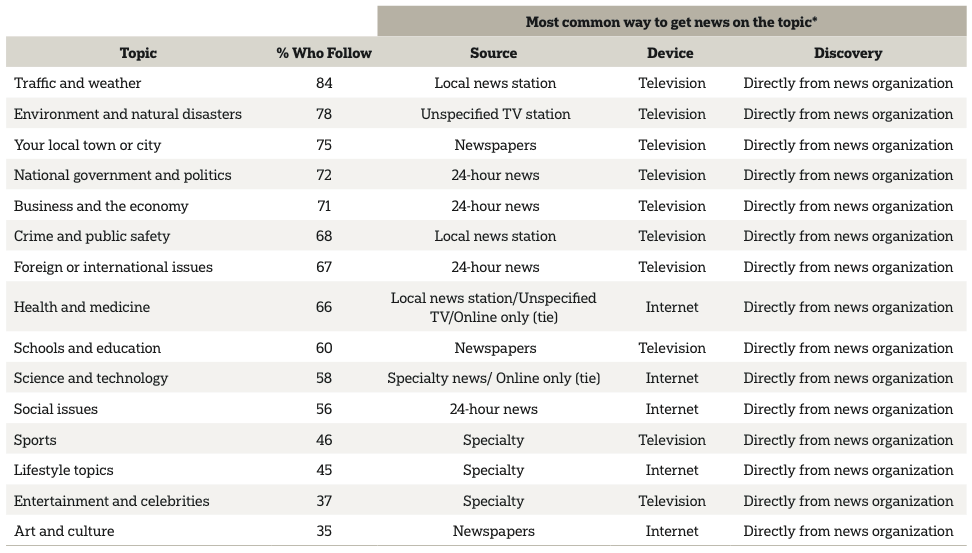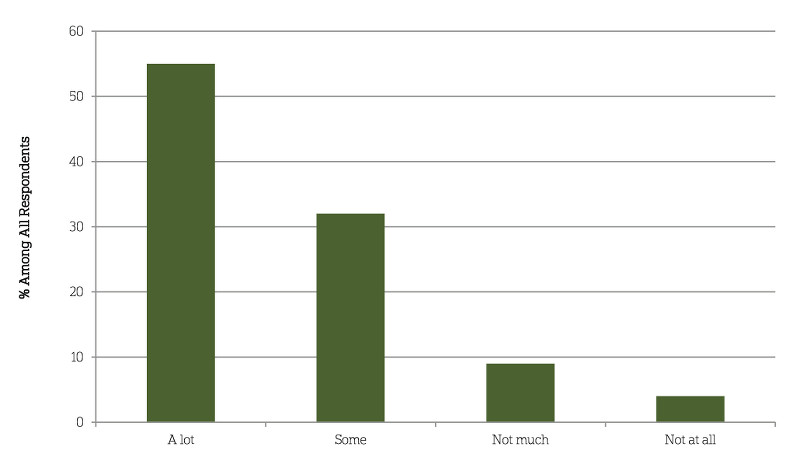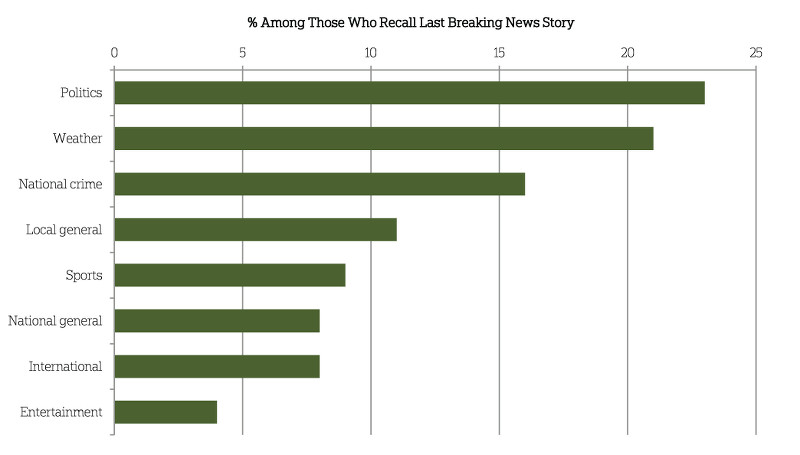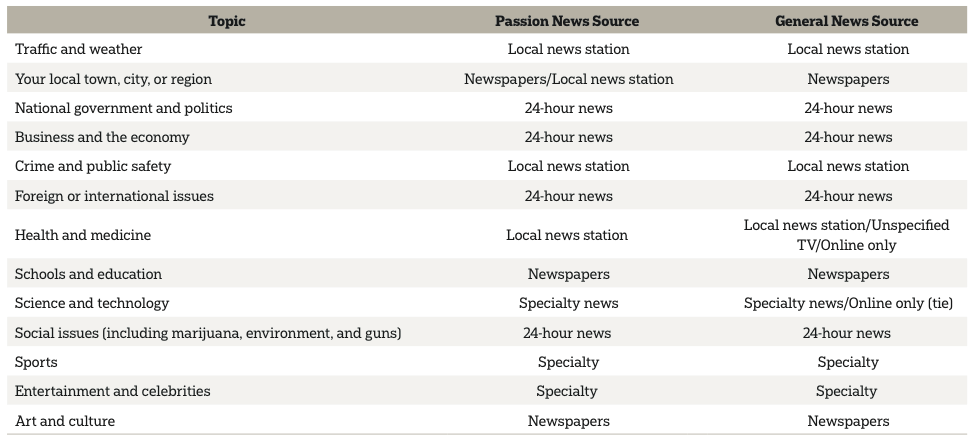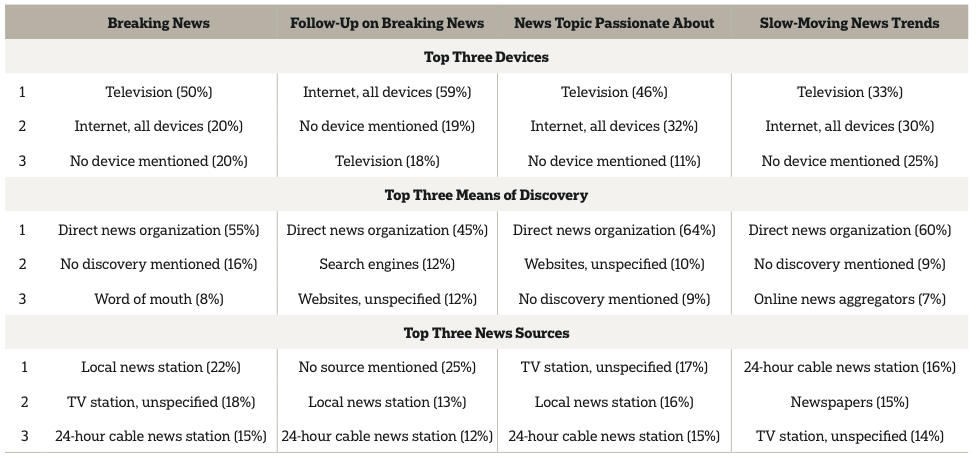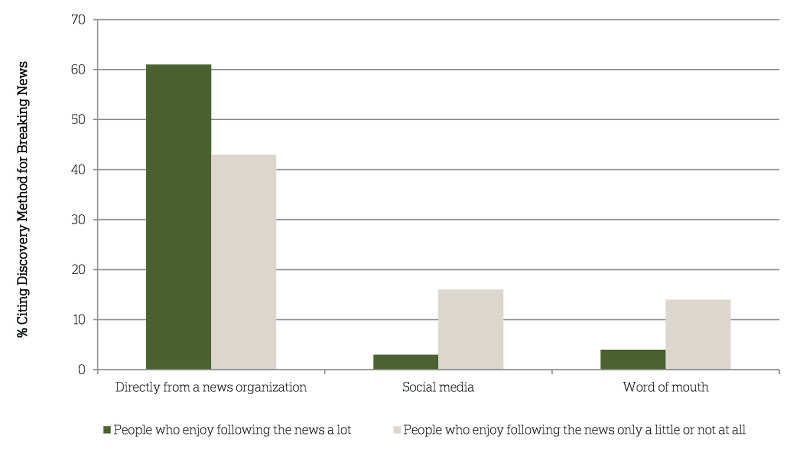Americans are discriminating news consumers whose habits vary by topic
In contrast to the idea that in the era of digital plenty people only follow news relating to a few matters about which they are really passionate, Americans consume news about a wide variety of subjects. In general, larger numbers of Americans report following current events and “news you can use” topics than follow news about entertainment and leisure.
Of all subjects covered by the survey, the most-followed is traffic and weather: 84 percent of respondents say they “try to keep up” with news about them. Two-thirds or more say they follow news about the environment and natural disasters, about their local town or city, national government and politics, business and the economy, crime and public safety, foreign or international issues, and health and medicine.
Fewer Americans report keeping up on leisure topics such as sports; lifestyle subjects such as food, exercise, or parenting; entertainment and celebrities; and art and culture.
The survey also tried to find out the degree to which Americans distinguish how they get news on different topics. Once again, respondents were asked if they could recall the device they usually used, the method they used to discover the news (i.e., through search, from social media, directly from the news organization, etc.), and what type of news source. Respondents were not given a defined list of answers; rather, they were asked to volunteer an answer of their own.
The most often-cited reporting source that consumers mention varies by topic. Newspapers are the most popular source of news about one’s local town or city (37 percent), art and culture (28 percent), and schools and education (21 percent). Newspapers also rank close to cable news as a source for news about business and the economy (15 percent).
Local TV news stations are the most popular source for news about crime and public safety (40 percent), traffic and weather (32 percent), and health and medicine (12 percent).
People are also turning to specialized news sources for some topics, ahead of traditional sources. For instance, specialty news sources are the most commonly mentioned source for news about sports (38 percent), entertainment (22 percent), lifestyle news (14 percent), and science and technology (10 percent).
Twenty-four hour news sources are most popular for news about foreign or international issues (31 percent), national government and politics (28 percent), social issues (24 percent), and business and the economy (21 percent).
Some people simply cite television as a source, not mentioning whether they mean cable, local, or network.
Indeed, television, unspecified, was the most popular news source mentioned about the environment and natural disasters (23 percent) and was also mentioned as often as local TV for news about health and medicine (12 percent). That number may suggest that, particularly for natural disasters, which tend to be visual stories, many people turn on the television to see them, not necessarily mindful or concerned about who the reporting source is. In the age of shared, syndicated video, the images may even all be the same.
The survey also found that a significant majority of Americans not only identify the reporting sources they encounter, they also prefer different ones for different subjects. Indeed, across all topics, an average of only 18 percent of news consumers do not mention a reporting source at all when asked where they go for news about a given topic.
Again, Americans are less likely to specify the device they use than the specific type of news organization they encounter. To a large extent, people mention either television or online if they mention a device at all. But overall, television carries the day. Television is especially popular for obtaining news about crime and public safety (55 percent), traffic and weather (48 percent), and sports (47 percent).
Digital devices trump television for several topics, including science and technology news (46 percent for online vs. 22 percent for television); health and medicine (40 percent vs. 31 percent); social issues like abortion, race, and gay rights (40 percent vs. 26 percent); lifestyle topics such as food, exercise, or parenting (36 percent vs. 24 percent); and art and culture (36 percent vs. 20 percent). On the internet, the most common news source that people mention using for these topics is online-only sources like Yahoo! News and The Huffington Post as compared with the websites of television stations, newspapers, or specialty news organizations.
People are more likely to cite a diversity of devices for getting news about traffic and weather than any other topic. Fifteen percent of Americans who follow traffic and weather report getting that news on their cell phones, while almost as many, 12 percent, report listening to it on the radio. Less than 1 in 10 of these same people specifically mentions using a cell phone, radio, or other device such as a tablet for all other topics.
Indeed, for many topics, device does not seem to be the first thing that comes to mind when people are asked to describe their news habits. Substantial proportions of consumers, 28 percent on average, do not mention a device when asked how they get news on a given subject. And there are some specific news topics (news about one’s local town or city, business and economy, and international events) where pluralities of Americans do not mention a device at all.
Americans are more conscious of the path they use to discover the news on a given subject—whether it was via social media, internet search, by going directly to a news organization’s content, or some other means. For all news topics, a plurality say they most often go directly to a news organization. For all topics except two—lifestyle, and science and technology—the majority specify going directly to news organizations.
Certain discovery methods are less popular overall, although their popularity varies by topic. Search engines are the most commonly mentioned means for finding news about science and technology (16 percent), health and medicine (14 percent), and lifestyle topics (12 percent). Mobile apps are very rarely reported for most topics, but they are used by nearly 1 in 10 (9 percent) for traffic and weather news. Social media is also a rare discovery method, but it is most commonly cited for news about social issues (7 percent), entertainment and celebrities (6 percent), and art and culture (6 percent).
Overall, Americans are attentive to news and follow different types, including breaking news, topics of personal interest, and slow-moving trends
Almost all Americans report that they pay attention to the news on a daily or weekly basis. Fully 76 percent of Americans report watching, reading, or hearing the news on a daily basis; another 14 percent report watching, reading, or hearing the news several times per week; and only 10 percent say weekly or less.
Fewer Americans invest additional time into following the news more in-depth. The survey asked people about going in-depth for news two different ways. It asked whether people generally tried to get news in-depth on any subject in the last week. It also asked, when they recalled a breaking news story they followed in the last week, whether they had tried to find out more about it after initially learning of it.
Overall, 41 percent of Americans report that they watched, read, or heard any in-depth news stories, beyond the headlines, in the last week. Slightly more people, 49 percent, report that they invested additional time to delve deeper and follow up on the last breaking news story they followed.
Interestingly, the people who delve deeper on general news are not the same as those who do more in-depth follow-up of breaking news. Among those who say they generally attend to news beyond the headlines, only just over half (54 percent) say they did so to learn more about the last breaking news story they followed (while 46 percent did not). And as described in Section 5 of this report, age is a significant predictor of the type of news people attend to in-depth. Yet contrary to what some might expect, younger adults are more likely to recall specifically going in-depth on breaking news than older adults. Older adults are more likely to say they follow up on news in general.
![Questions: In the last week, did you watch, read, or hear any in-depth news stories, beyond the headlines, or not? Did you try to find out more about that breaking news story, or not? [Asked of the 85% who recently followed breaking news.]](https://americanpressinstitute.org/wp-content/uploads/2014/03/PersNewsCycle-Exhibit_10.jpg)
Questions: In the last week, did you watch, read, or hear any in-depth news stories, beyond the headlines, or not?
Did you try to find out more about that breaking news story, or not? [Asked of the 85% who recently followed breaking news.]
To try to probe how people get news today, the survey asked people to recall the last breaking news story they followed, and then it tracked how they did it.
The vast majority of Americans, 85 percent, recalled the last breaking news story they watched, read, or heard about as it unfolded, while 14 percent could not, and less than 1 percent of Americans said they do not pay attention to breaking news stories.
The types of breaking news stories that Americans recalled following varied. The survey was conducted largely in January and two weeks of February of 2014. During that time, there were several breaking news stories, including a political scandal involving New Jersey Governor Chris Christie, a nearly nationwide winter weather event, the run-up to the Winter Olympics, a school shooting in New Mexico, and a large chemical spill in West Virginia.
Twenty-three percent of Americans who recalled the last breaking news story they paid attention to named a political news story, the biggest two being the Chris Christie bridge scandal (13 percent) and news about the Benghazi attack and subsequent fallout (2 percent). Another 21 percent said the last breaking news story they paid attention to was weather related, led by the January 2014 polar vortex (8 percent) and the California wildfires (2 percent). And 16 percent of Americans said the last breaking news story they paid attention to was a national crime story such as the New Mexico school shooting that took place in January 2014 (1 percent).
Other types of breaking news stories that Americans mentioned pertained to a local news event (11 percent), sports news (9 percent), international news (8 percent), general national news (8 percent), and entertainment news (4 percent).
And where did people go for breaking news? Half of news consumers who named a breaking news story say they first heard about it from television. About half of those (49 percent of adults) then tried to learn more. Few stuck with television. A majority moved to the web (using a number of devices) rather than continuing to follow the story on television (59 percent vs. 18 percent).
When it comes to following up on breaking news, fewer Americans report hearing the news directly from a news organization, and more Americans discover breaking news through user-controlled means. In all, 45 percent seeking more information about a breaking news story said they discovered the news directly from a news organization, fewer than for any other kind of news. Although the means people used to discover more about a breaking news story varied, generally people made more use of the aggregation and search capabilities of the web for breaking news than for other kinds. In all, 12 percent said they used search, 12 percent said unspecified websites, and 10 percent mentioned online news aggregators.
Still, when they finally landed somewhere, even when it came to breaking news people said they tended to go to news reporting sources that had some history or legacy in traditional media. In all, 37 percent said they went to a TV-based reporting organization (13 percent local TV news, 12 percent cable, 1 percent a national broadcast station, and 11 percent unspecified). Another 9 percent said they went to newspaper-based reporting organizations. Ten percent said they went to online-only sources, and 8 percent to specialized media sources, some legacy and some online-only.
The survey also probed two other kinds of stories beyond breaking news: how people followed news about topics that they were particularly passionate about—to see whether intensity of interest altered behavior—and how they got news about other slower-moving trends, such as the economy or the environment, even if those topics were not ones that they were particularly passionate about. The approach was an experiment above all, to see if there were distinctions between the three kinds of news: breaking, slow-moving, and passion topics.
Nearly all Americans follow slower-moving news trends (94 percent) and news related to topics that they are passionate about (95 percent). The topics people are most passionate about vary widely, with no one topic exceeding 21 percent. The list is led by politics and government, local town news, traffic and weather, and business and sports.

Question: Thinking about the types of news that you do pay attention to, what is a topic that you are really passionate about?
In general, people show some consistent news-gathering habits across types and some customized behaviors depending on the type of news they are following. Much the way people tailor how they find out about news and their go-to sources for the news topic they follow, they also adjust their behavior for the type of news they follow.
Averaging across all topics, when it comes to how consumers follow news they feel passionately about, their news-gathering habits are similar to those for following slower-moving news trends. In both cases, TV and the internet (across devices) are the most common platforms for this type of news. Like other types of news, most people report discovering the news they feel passionately about directly from a news organization.
However, looking specifically at the news topics that people feel passionately about, the data suggest that their habits are shaped by the topic more than the intensity or the speed of the news. The most common go-to news sources for the topics they feel passionately about mirror those mentioned for following different topics regardless of intensity. For example, cable news is the most commonly mentioned source for news on national government and politics, and newspapers are the most commonly mentioned source for schools and education among those who follow that topic passionately and among those who follow that news generally. The same patterns hold true across device and discovery—the topic is more closely related to news-gathering habits than the speed of the news or the intensity with which it is followed.
Across all news types, people most often discover news directly from a news organization. Fast-paced, breaking news is also discovered by word-of-mouth. When people who don’t go directly to a news organization are following up on breaking news or looking for news on slower-moving stories, they tend toward online means, including news websites, search engines, and online news aggregators.
Consumers think more about the reporting source and means of discovery than they do about the device
As with news in general, even on fast-moving events, people are more inclined to remember the news reporting sources from which they sought the information and how they found it rather than the device they used. More than 85 percent of people can describe the news source they turned to first for the last breaking news story they remember and for slower-moving trends they follow in the news, and on average 82 percent can name the specific type of news source they turn to most often on any given topic. Similarly, more than 80 percent of people can identify the means they used to discover (search vs. social vs. going straight to a news provider) breaking news, news trends, or news on different topics. But far fewer can name the devices used. More than a quarter cannot name a device they generally used to follow any trend or topic, on average.
When devices are named, television still reigns, though less so among younger adults (see additional detail in Section 5). And this holds true regardless of the type of news: television is the most popular device for breaking news stories, passionate topics, or trend news, as well as roughly half of the specific news topics covered in this survey, and particularly for topics that are time sensitive, such as crime and public safety, traffic and weather, natural disasters, politics, and sports.
Where television’s hold is less secure is both among younger adults in general and in two other circumstances: when people are looking for more information about a breaking news story and for some topics that may be less time sensitive, such as science and technology, health and medicine, social issues, lifestyle topics, and art and culture. In all of these instances, again, people are more inclined to turn to the devices that access the web.
Once again, beyond the technology or device, a majority of Americans say they get news directly from news organizations regardless of the kind of story (fast or slow- moving) or the topic. But more avid news consumers are more likely than others to seek out news organizations directly. Fully 61 percent of those who say they enjoy keeping up with the news say they learned about the last big breaking news story directly from news organizations, versus 43 percent of those who don’t enjoy the news that much, more of whom learned about it in a less direct fashion. Less avid news consumers, in turn, are more likely to cite friends, colleagues, and family members as the way they discover breaking news (14 percent for the least avid vs. 4 percent for the most avid news consumers).
Share with your network
- The Personal News Cycle: How Americans choose to get their news
- How Americans get their news
- Social and demographic differences in news habits and attitudes
- Personal News Cycle study methodology and background
- Download the Personal News Cycle study report or topline results
- The rational and attentive news consumer
- Americans’ perceptions of the current news environment
You also might be interested in:
The two organizations will provide a series of monthly webinars to local media leaders and journalists in the months leading up to the 2024 U.S. elections, and share practical resources throughout the year to support news organizations’ evolving needs around local elections and democracy.
We challenge local news organizations to smartly deploy their resources around the elections that most matter to their communities in 2024 — and also to think about how that energy builds to something more robust and sustained.
Journalism has the power to connect our communities, to bring out the best in what our society can be. Our goal is to help us all get there.

